What is stimulus fading in ABA

Understanding Stimulus Fading in ABA Therapy
Stimulus fading is a fundamental technique used in Applied Behavior Analysis (ABA) to promote independent and generalized responding by gradually reducing reliance on prompts or salient stimulus features. This article explores the definition, procedures, techniques, and applications of stimulus fading, illustrating its importance in effective behavioral interventions, especially for individuals with autism spectrum disorder and other developmental conditions.
Defining Stimulus Fading in ABA
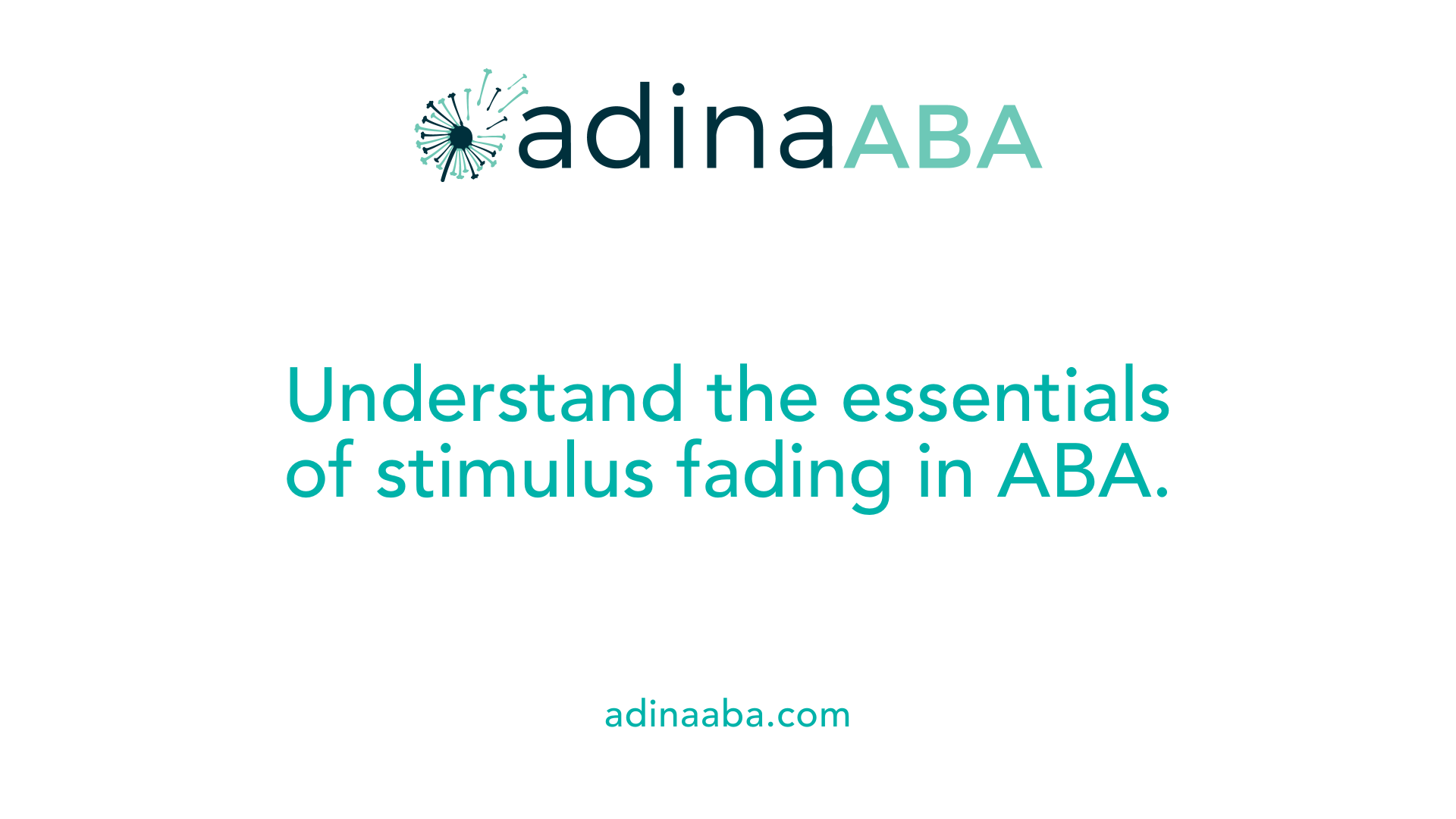
What is the definition of stimulus fading?
Stimulus fading is a behavioral technique used to gradually decrease the prominence or intensity of a stimulus that initially helps elicit a response from an individual. The process involves systematically reducing a physical or perceptual characteristic of the stimulus, such as size, brightness, or proximity, to shift control of the behavior from a highly prompting stimulus to a more natural or less intrusive cue.
This approach is fundamental in Applied Behavior Analysis (ABA) because it encourages learners to respond to stimuli in a more natural environment without over-reliance on exaggerated cues. For example, an instructor may start by using a brightly colored card to prompt a student to identify the correct answer. Over time, the brightness of the card is gradually faded until the student responds solely to the natural stimuli without the prompting aid.
The core purpose of stimulus fading is to promote independent responses. By systematically decreasing the stimulus's prominence, the learner begins to respond based on the natural stimulus rather than the prompt or enhanced cue. This process supports skill generalization, making behaviors more adaptable across various settings and reducing prompt dependence.
In practice, stimulus fading can involve changes in multiple stimulus features, such as size, color intensity, shape, or the distance between stimuli. This flexibility allows therapists, teachers, and caregivers to tailor interventions to each individual’s needs, whether teaching new skills or decreasing maladaptive behaviors.
Overall, stimulus fading helps bridge the gap between guided learning and independent functioning, contributing to more robust and durable behavior change in various therapeutic and educational contexts.
Procedures and Techniques Employed in Stimulus Fading
Stimulus fading in Applied Behavior Analysis (ABA) involves a systematic approach to modifying various properties of stimuli to transfer control from prompts or salient cues to more natural stimuli. This process encourages independent responding and promotes generalization of skills across different environments and situations.
One of the main techniques in stimulus fading is the gradual alteration of physical characteristics such as size, brightness, color intensity, or texture. For example, a teacher might start with a brightly colored card to help a student identify the correct answer during a matching task. Over time, the brightness is decreased or the color is faded, allowing the student to recognize the stimulus without exaggerated cues.
In addition to physical modifications, stimulus fading often involves changing the proximity or distance of stimuli. An example would be marking drawers with a bright line for a child to put away clothes, then gradually removing the marking as the child's response becomes more consistent.
Fading is also applied by increasing the complexity of discrimination tasks. This involves adjusting stimuli so that the learner must differentiate between more subtly different stimuli or respond under more challenging conditions. Such systematic adjustments enable learners to respond correctly with minimal or no prompts.
When used across different behaviors, stimulus fading can address a variety of goals, including teaching new skills, reducing fears, and increasing acceptance of sensory stimuli, such as food textures. For example, in phobia treatment, exposure to the feared stimulus is gradually increased, reducing anxiety and promoting desensitization.
In practice, stimulus fading may include procedures like stimulus shaping—initially using a slightly altered stimulus that resembles the natural cue and gradually transforming it into the original form. Similarly, in stimulus control transfer, prompts are systematically faded while the natural stimulus is made more prominent, encouraging the learner to respond independently to real-world cues.
Overall, stimulus fading is a flexible, non-intrusive technique suitable for various settings such as clinics, classrooms, or homes. Its systematic nature ensures that the learner builds confidence and skill mastery without becoming overly dependent on prompts, thereby fostering autonomous and generalized responses.
The Relationship Between Prompt Fading and Stimulus Fading
How does stimulus fading differ from prompt fading?
Stimulus fading and prompt fading are both essential techniques used in Applied Behavior Analysis (ABA) to promote independence and skill mastery, but they target different aspects of stimulus control. Stimulus fading involves gradually altering the physical features of a stimulus—such as its size, color intensity, shape, or proximity—to make it less salient and help the individual respond to the natural, unprompted stimulus. For example, a teacher might use a brightly colored card to prompt a child to identify a letter and then slowly fade the brightness or size of the card over time.
Prompt fading, on the other hand, focuses on systematically reducing the assistance or cues—such as physical guidance, verbal hints, or visual cues—that are used to evoke a correct response. This can include gradually withdrawing physical prompts, delaying prompts in time, or simplifying verbal cues until the individual can perform the behavior independently.
Both methods ultimately aim to transfer control from external aids to natural stimuli, but they do so through different approaches. While stimulus fading reshapes the environment or stimulus itself to evoke the correct response, prompt fading reduces the external assistance that guides the response.
How do these strategies complement each other?
When combined, stimulus fading and prompt fading work synergistically to facilitate skill acquisition and ensure that learned behaviors are maintained across various settings. By fading prompts, learners become less dependent on external cues for initiating responses. Simultaneously, by changing the stimulus properties, the stimuli become more representative of their natural forms, promoting generalization.
For instance, in teaching a child to recognize a picture of an apple, a therapist might initially use a brightly colored, large image paired with physical prompts. Over time, the prompts are faded out, and the size or brightness of the image is gradually reduced. This dual fading process helps the child respond correctly without reliance on prompts or exaggerated stimuli, fostering true skill independence.
How are they applied together in teaching?
In practical settings, teachers and therapists often employ both techniques in sequence or simultaneously within a structured intervention. Initial sessions might focus on prompt fading to establish the correct response. As the learner advances, stimulus fading is introduced to make the stimuli resemble their natural counterparts more closely.
A typical process might involve:
- Starting with highly salient stimuli with prompts.
- Gradually reducing prompts to encourage independent responses.
- Simultaneously or subsequently, decreasing the prominence or intensity of the stimulus features (such as size or brightness).
- Reinforcing correct responses at each stage to promote retention.
This integrated approach not only enhances learning efficiency but also supports the generalization and maintenance of skills in everyday environments.
Stimulus Control Transfer in ABA: Principles and Methods
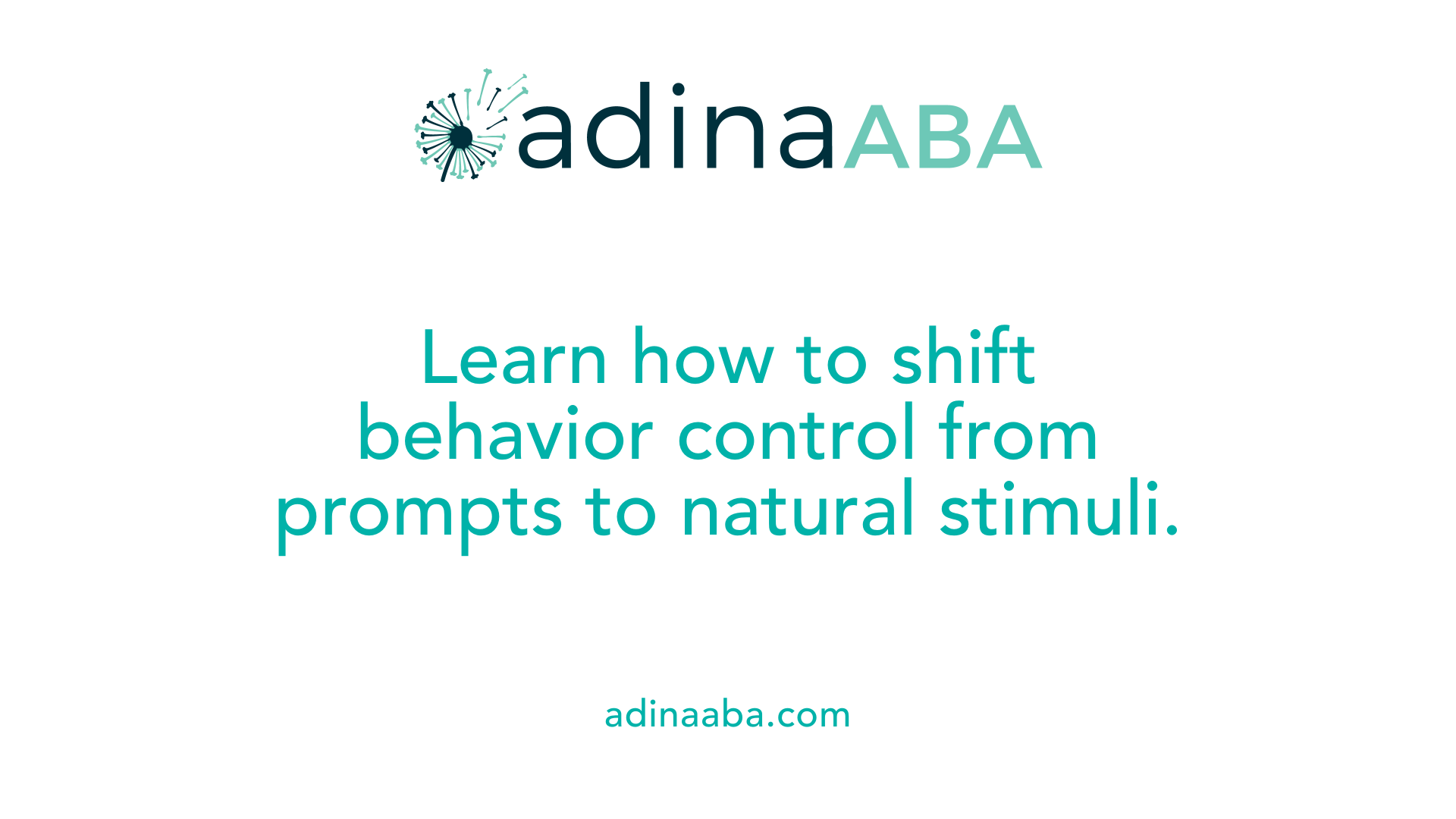
What is stimulus control transfer in ABA therapy?
Stimulus control transfer is an essential concept in Applied Behavior Analysis (ABA). It involves shifting the control of a behavior from a prompt or artificial stimulus to a natural or environmental stimulus. This process ensures that responses become more functional and adaptable to real-world situations.
The procedure typically begins with a prompt or cue that helps the individual perform the desired behavior. Over time, prompts are systematically reduced or faded, allowing the response to be controlled by natural stimuli. Common techniques include prompt fading, prompt delay, and stimulus fading.
The main goal is for the individual to respond appropriately to natural cues without relying on external prompts, which fosters independence. This transition supports skill generalization across different contexts and reduces dependency on assistance. Ultimately, stimulus control transfer helps promote lasting and functional behavior change, making it a vital strategy in teaching new skills and reducing maladaptive behaviors in individuals with developmental disabilities, such as autism.
Applications and Benefits of Stimulus Fading
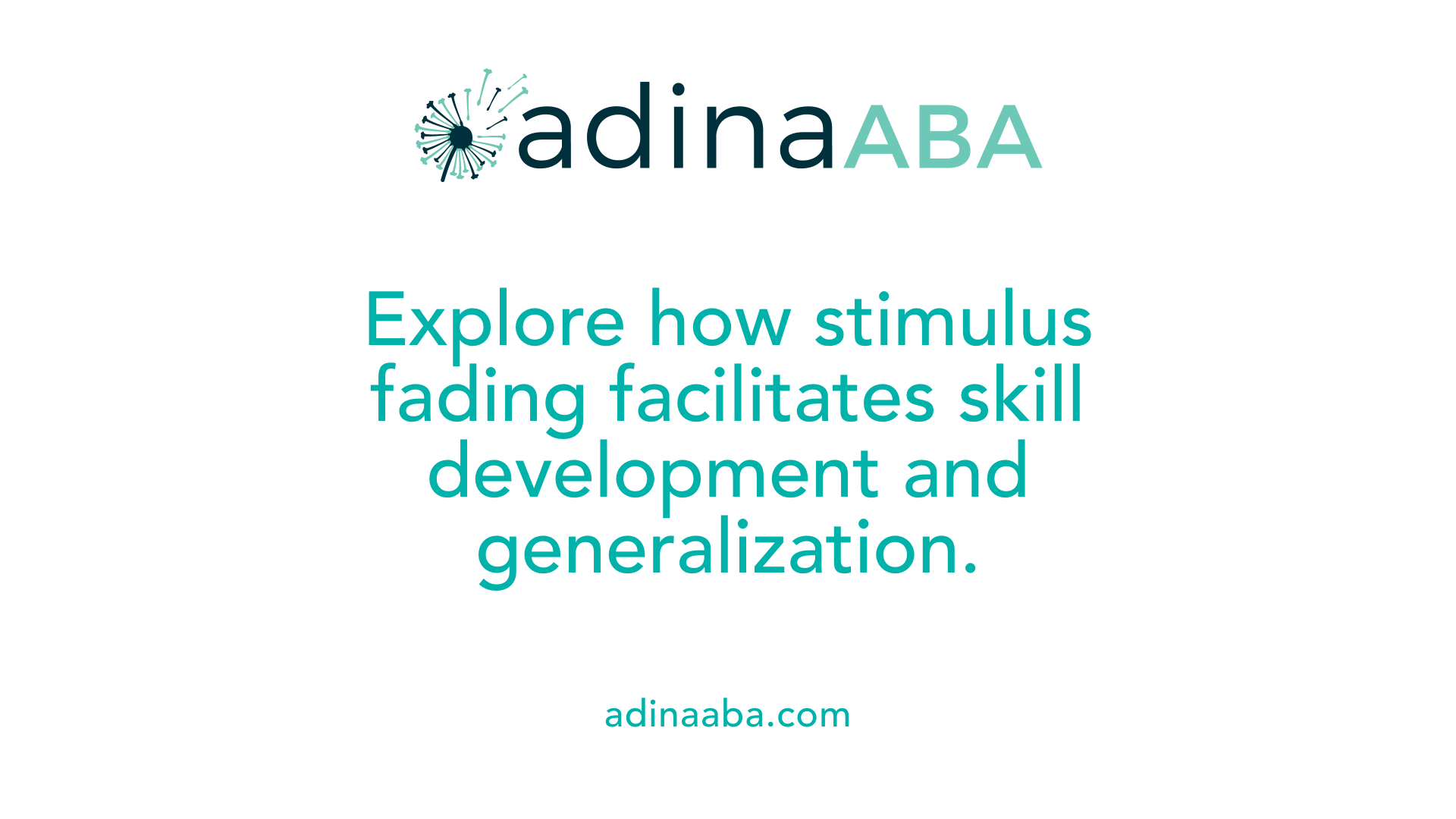 Stimulus fading is a versatile procedure used in Applied Behavior Analysis (ABA) to help individuals develop and maintain desirable behaviors. This technique involves systematically modifying a stimulus’s properties—such as size, color, intensity, or proximity—to transfer control over responses from prompts or overly salient features to natural, relevant stimuli.
Stimulus fading is a versatile procedure used in Applied Behavior Analysis (ABA) to help individuals develop and maintain desirable behaviors. This technique involves systematically modifying a stimulus’s properties—such as size, color, intensity, or proximity—to transfer control over responses from prompts or overly salient features to natural, relevant stimuli.
One significant application of stimulus fading is in discrimination training, where it helps individuals distinguish between different stimuli. For example, a child might initially respond to a brightly highlighted letter or object. Over time, the highlighting is gradually faded, enabling the child to respond to the entire stimulus without relying on exaggerated cues. This approach is effective in teaching letter recognition, color identification, and other matching tasks.
Stimulus fading is also employed to reduce food refusal in children. For instance, a parent or therapist might start by increasing the size or brightness of a food item, encouraging acceptance. Gradually, these features are faded back to the normal presentation, helping the individual respond naturally to the food itself.
Beyond educational settings, stimulus fading plays a crucial role in addressing fears and phobias. It is often combined with systematic desensitization techniques to help individuals overcome anxieties related to needles, animals, or other feared stimuli. By initially exposing the individual to a highly manageable version of the stimulus and slowly reducing its prominence, stimulus fading can decrease fear responses and promote relaxation.
The benefits of employing stimulus fading extend to fostering independence. By gradually removing external prompts or exaggerated cues, individuals learn to respond to natural stimuli in everyday environments. This process diminishes prompt dependency, enhances behavioral flexibility, and encourages generalization across different contexts. For example, a child who initially requires visual cues to initiate a task can, through stimulus fading, come to perform the task independently based on environmental cues alone.
Stimulus fading is adaptable to various settings, including clinics, homes, and schools, making it an accessible tool for practitioners, parents, and teachers. Its effectiveness is supported by clinical examples where the technique has been used to elaborate and transfer responses, such as identifying objects, responding to environmental signals, or wearing clothing. When systematically implemented, stimulus fading facilitates the acquisition of functional skills and reduces maladaptive behaviors.
In summary, the broad application of stimulus fading covers discrimination training, behavior reduction, anxiety management, and promoting independent functioning. Its systematic, gradual approach ensures that responding becomes more natural and less reliant on artificial prompts, thereby supporting lasting behavioral change and skill generalization.
Real-Life Examples Demonstrating Stimulus Fading
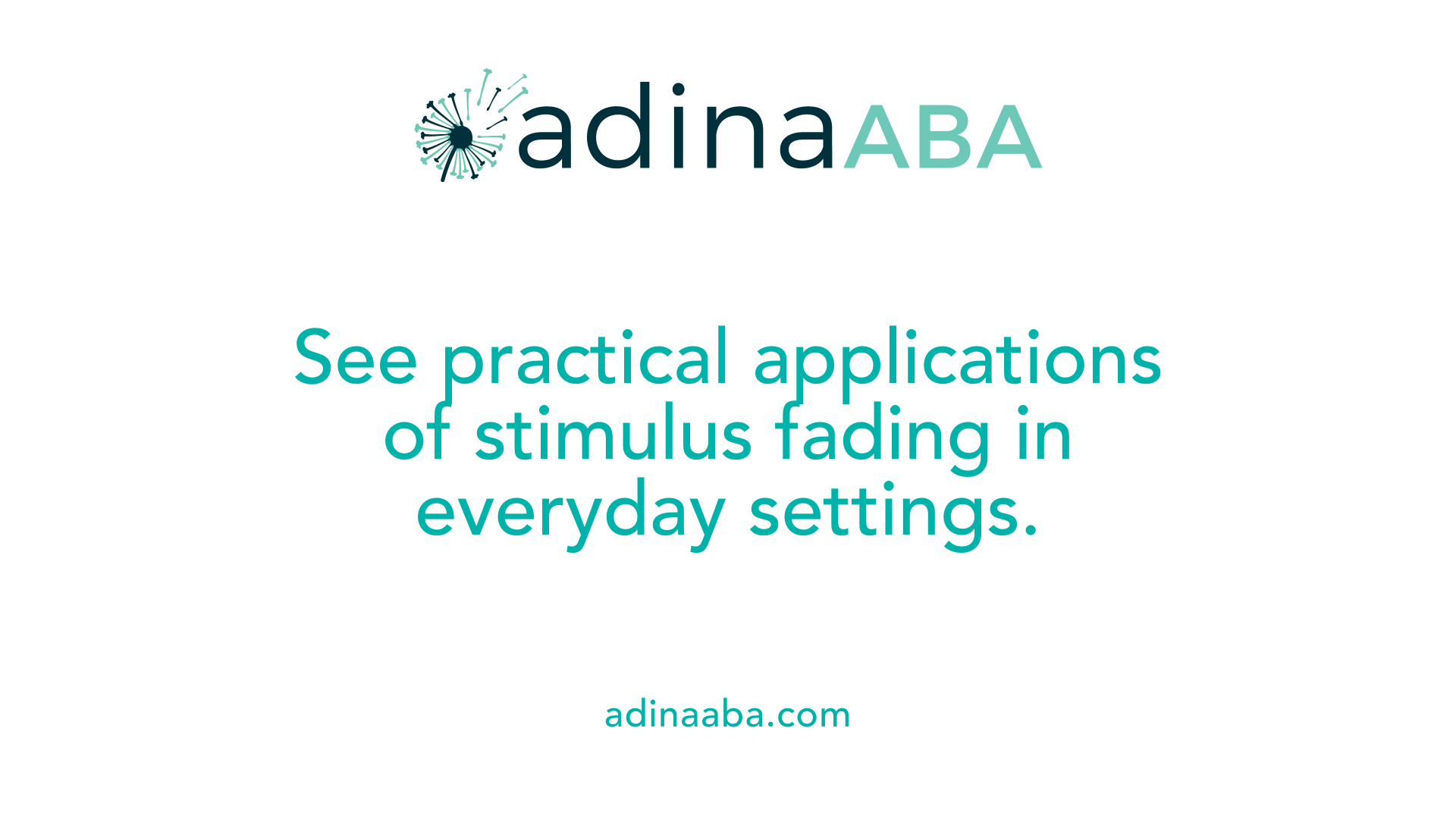
Can you provide an example of stimulus fading in ABA?
Stimulus fading is a versatile technique commonly employed in ABA to help individuals develop independence in various behaviors. A classic illustration involves teaching a child to recognize colors. Initially, an instructor might use a brightly colored card as a prompt, making it highly noticeable to capture the child's attention. Over subsequent sessions, they systematically reduce the card's prominence by decreasing its size, dimming its brightness, or shortening the duration it is presented. This gradual reduction helps the child learn to respond to the color itself, rather than the exaggerated cue.
In speech therapy, stimulus fading plays a crucial role as well. Therapists may start with exaggerated visual cues, such as large, brightly colored flashcards, to signal pronunciation or word recognition. As the child's responses improve, the prompts are gradually minimized, perhaps by reducing the size of the cue or replacing it with more naturalistic cues. This process promotes independent articulation and comprehension skills.
Another practical example is in exposure therapy for children with selective mutism or food refusal. A therapist might initially work very close to the child, using close proximity prompts or tactile cues to encourage speech or acceptance of food. Over time, the therapist systematically increases the distance between themselves and the child, decreasing the level of external prompting. This step-by-step fading encourages the child to perform responses independently, relying less on external cues.
Stimulus fading is also used extensively in reducing fears, such as needle phobia. For example, in systematic desensitization, a child might start by observing a drawing of a needle, then progress to viewing a real needle from a distance, and eventually to holding a syringe. Each step involves gradually reducing the perceived threat or prominence of the stimulus, helping to diminish fear responses.
In daily routines, parents might use stimulus fading to teach simple tasks. Indy’s father, for example, marks her drawers with an orange line to help her learn how to put away clothes. As Indy becomes more proficient, her dad gradually removes the line, encouraging her to respond to the natural cue—her drawer—rather than reliance on the visual prompt.
Through these examples, stimulus fading demonstrates its effectiveness in transferring stimulus control, promoting independence, and ensuring behaviors are maintained across various environments and situations.
Enhancing Learning Outcomes and Promoting Independence through Stimulus Fading
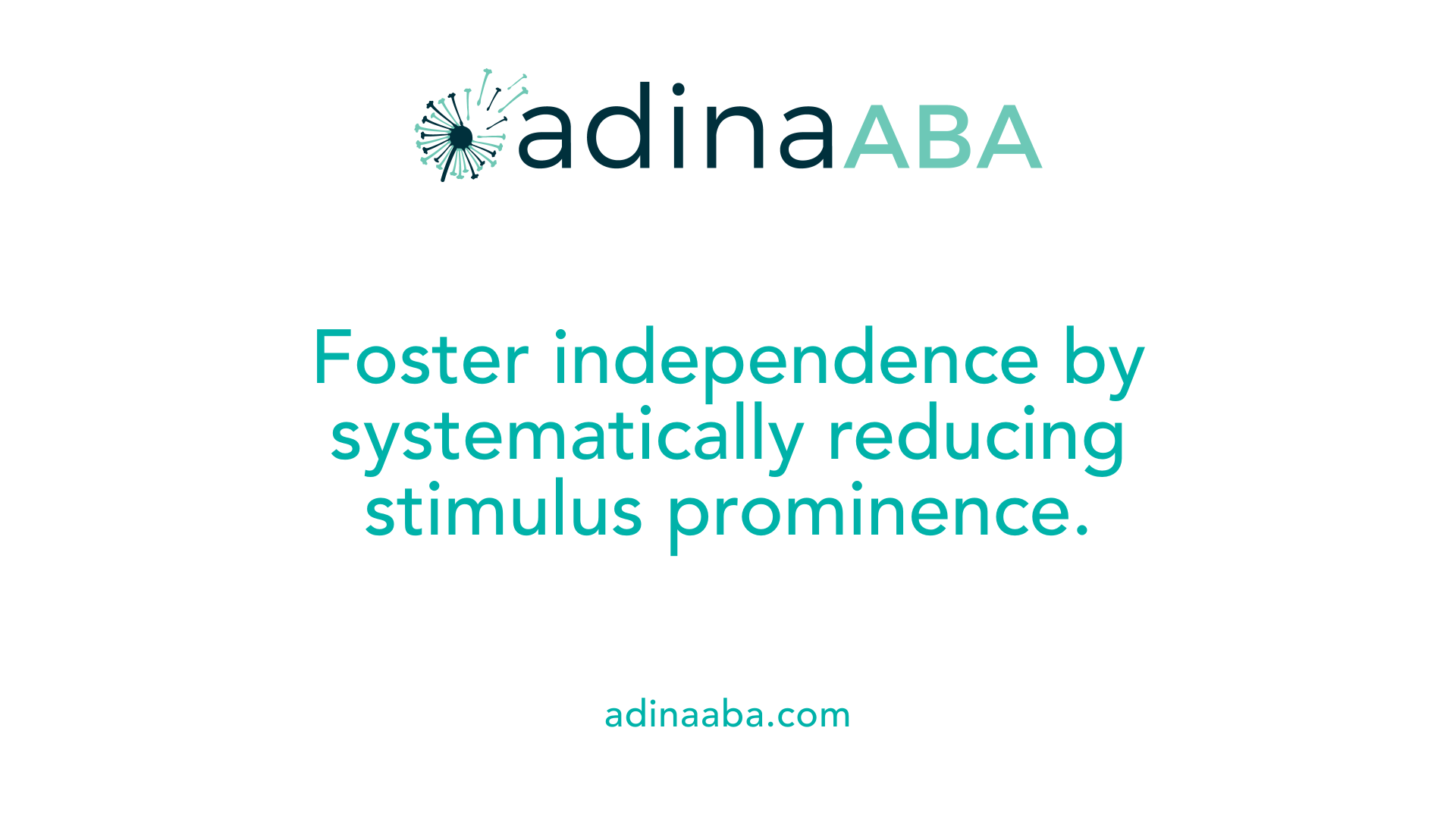
How does stimulus fading differ from prompt fading?
Stimulus fading and prompt fading are both techniques used within Applied Behavior Analysis (ABA) to help individuals develop skills independently, but they target different aspects of the learning process.
Stimulus fading involves systematically changing the physical properties of a stimulus — such as size, color intensity, shape, or proximity — to encourage responses to the natural, or target, stimulus without reliance on exaggerated cues. For example, a teacher might initially use a brightly colored card to help a student identify a correct answer during a matching task. Over time, the teacher gradually reduces the brightness or size of the card until the student responds accurately based on the natural stimulus alone.
Prompt fading, on the other hand, involves gradually decreasing the level of assistance, hints, or cues used to evoke a response. For instance, a teacher might start by physically guiding a child's hand to write a letter and then slowly reduce the physical assistance until the child can write the letter independently without any help.
While both methods aim to foster independence, stimulus fading focuses on altering the stimulus itself to make it resemble the natural environment more closely, encouraging the individual to respond to cues in their everyday surroundings. Prompt fading emphasizes reducing external prompts or assistance that temporarily guide behavior.
In practice, both techniques are often used together to facilitate skill transfer from a highly structured setting to real-world independence. Effective application of stimulus fading ensures that responses become more natural and adaptable, helping individuals maintain behaviors without dependence on artificial cues or prompts.
What are the benefits of stimulus fading?
Using stimulus fading in behavioral interventions offers several advantages. It promotes the generalization of skills across various settings by reducing reliance on artificial cues. This means behaviors learned through stimulus fading are more likely to be performed correctly in everyday environments.
It also helps maintain learned behaviors over time, as responses become controlled by natural stimuli rather than prompts or exaggerated features. Additionally, stimulus fading builds confidence and encourages learners to respond to real-world cues, fostering independence.
Furthermore, this technique supports skill retention and reduces the likelihood of prompt dependency. By gradually diminishing the salient features of stimuli, individuals learn to recognize and respond to subtler cues, simulating everyday situations more accurately.
How does stimulus fading promote generalization and maintenance?
Stimulus fading facilitates generalization by helping learners respond correctly to varied representations of a stimulus. For example, a student taught to identify a letter 'E' with highlighted parts will, through fading, learn to recognize the entire letter in different fonts, sizes, or contexts.
To ensure maintenance, stimulus fading is systematically planned and implemented across different settings and stimuli. This consistency helps individuals transfer skills from a structured learning environment to natural settings such as home, school, or community. As the physical features of stimuli are gradually withdrawn, responses that are controlled by the natural stimulus are reinforced, leading to durable behavior.
Moreover, combining stimulus fading with reinforcement strategies ensures that responses remain stable over time, supporting long-term independence. This integration of techniques is particularly crucial in applications like language learning, social skills, and daily living activities.
Building confidence and natural responses
A critical aspect of stimulus fading is its role in building learners' confidence. As the individual responds accurately even as cues become less exaggerated or assistance is removed, their confidence grows.
Encouraging natural responses straightforwardly translates to behaviors that are more flexible and applicable in real-world situations. Over time, individuals learn to rely on subtle cues or environmental signals rather than artificial prompts, which enhances their overall functional independence.
By gradually reducing the salience of stimuli and prompts, stimulus fading ensures that learners are not only acquiring new skills but also mastering the ability to perform them in authentic contexts, fostering genuine independence and self-reliance.
The Power of Gradual Change in Behavior Support
Stimulus fading stands as a cornerstone technique within ABA, enabling individuals to develop independence, flexibility, and resilience across various behaviors and settings. By systematically reducing reliance on artificial prompts and salient stimulus features, practitioners can foster natural responses that are stable, generalizable, and sustainable. Whether used to teach new skills, address phobias, or promote functional behaviors, stimulus fading exemplifies the power of systematic, incremental change in behavioral intervention, making it a vital tool for therapists, educators, and caregivers committed to enhancing quality of life.
References
- Stimulus Fading - an overview | ScienceDirect Topics
- Stimulus fading - Pass the Big ABA Exam Glossary
- What is Stimulus Fading in ABA? - BehaviorPREP
- Stimulus Fading and Response Elaboration in Differential ...
- Stimulus Fading - ABA Study Guide
- Stimulus Fading and Differential Reinforcement for the Treatment of ...
- 6e.G-8: Design and implement procedures to fade stimulus and ...
- Stimulus Control Transfer in ABA - Psych Central
- Fading in ABA Therapy: How Does it Promote Independence...
More Resources
Expert Clinicians
Get started today ->






